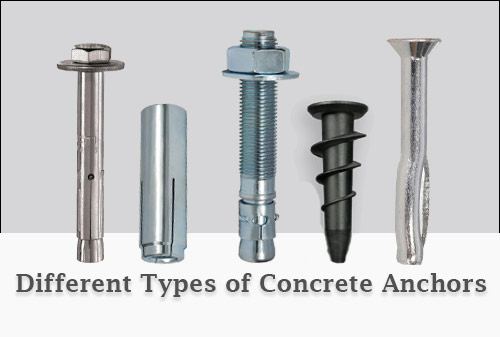Since anchors are used for connecting different kinds of elements to concrete bases, you need to be careful in choosing the right one.
It will be tricky to choose one for the structural or non-structural element that you’re dealing with. Connecting the elements with bases doesn’t necessarily have to be done with anchors. You can also use stiffeners or steel plates as a kind of fastener.
Among the anchor kind of fasteners, there are many types of concrete anchors you can choose from. Each of the concrete anchors will do the same job, but they also have their own special features. You can understand the difference when you use them to see for which situation the concrete anchor fits best.
Types of Concrete Anchors
If you want to learn about the various kinds of concrete anchors, then the following list of anchor types along with their descriptions is given below:
1. Wedge Concrete Anchors
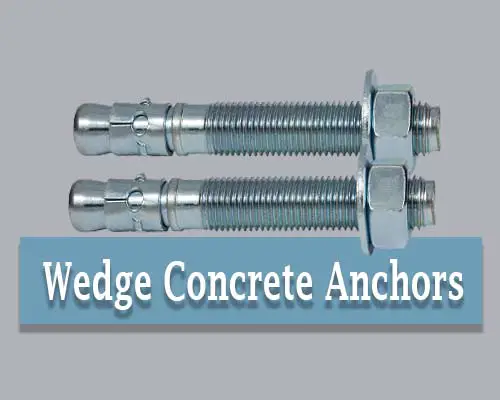
Wedge concrete anchors were named after wedges that can open up and expand till it is 1/16th of an inch around its base. When the bolt is already tightened, this expansion occurs.
A concrete wedge anchor of this type is considered a male anchor. That is because the male anchors are used to fasten to the concrete base by the use of a washer and a nut.
Anchors here are inserted through the object or a fixture. The male anchors are then inserted into a hole that was already drilled before. Male wedge anchors are the most popular because they can be inserted easily, prevent corrosion, and are very strong.
Wedge concrete anchors consist of a small stud that connects two pieces. One of these pieces is threaded on one end. The other end basically consists of a mechanism including a clip and a wedge.
That wedge is the part that expands between the wall of the concrete base’s hole and the stud part. Such wedge concrete anchors are the best option when you have to deal with heavy shear applications or heavy load tasks. For seismic activities, there are specific heavy-duty seismic wedge anchors available too.
2. Concrete Sleeve Anchor

Concrete sleeve anchors are male anchors or fasteners like the previous one. It involves a threaded bolt being enveloped or surrounded by an expander sleeve at one end, while at the other end there is a washer and a nut.
The anchor is then threaded through a fixture and then inserted into a previously drilled-in hole on the base. The base can either be concrete, mortar, stone, or other elements since concrete sleeve anchors are suitable for all of these elements.
When you turn the nut on the bolt, it will pull the bolt upwards through the sleeve. This will make the sleeve flare out till it is 1/8th of an inch. This is what creates the grip or hold that is required.
3. Split Drive Concrete Anchors
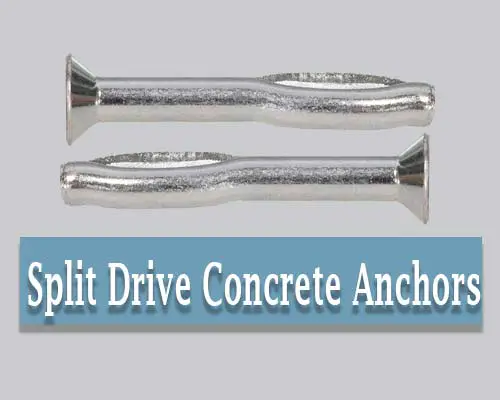
Split drive concrete anchors get their holding power from the source of the resilient composition of the one-piece anchor itself. These anchors are male anchors with a split expanded base.
The anchor itself is made of a tough kind of carbon steel. When you hammer the split drive anchor into a hole that was already drilled out, the split base will become compressed.
While you are hammering, the split base will maintain an outwards pressure on the hole’s walls. This gives the split drive anchor the holding power it needs.
When you want to install a split drive concrete anchor, you need to make sure that the size of the drilled-out hole is the same diameter as that of the split drive anchor's base. Usually, split drive concrete anchors are best suited to light-duty tasks. They are suitable for either concrete, block, or brick materials as the base.
4. Stud Concrete Anchor
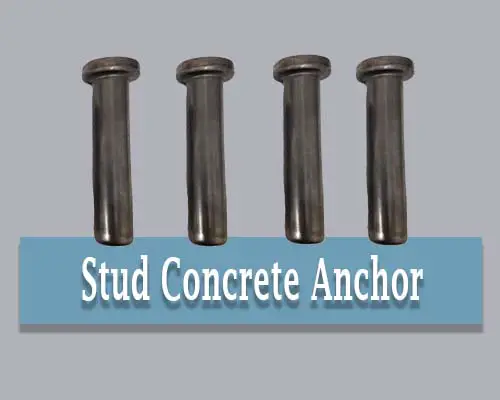
As we know, the wedge and sleeve concrete anchors use a tightened nut so that the anchors expand a lot against the hole’s walls or sides. The stud anchor also expands.
But to expand a stud fastener you need to hammer onto the top part of the stud. The stud expansion anchor has threading on the top end and on the bottom end, there is a drilled hole consisting of vertical slits.
At the bottom end of the stud anchor, there is a hole that sits on the tapered steel plug. When you hammer onto the top part of the stud, the bottom part of the steel stud will be forced to be set over the tapered steel plug. This makes the steel stud expand against the hole’s sides or walls.
5. Drop-in Concrete Anchor
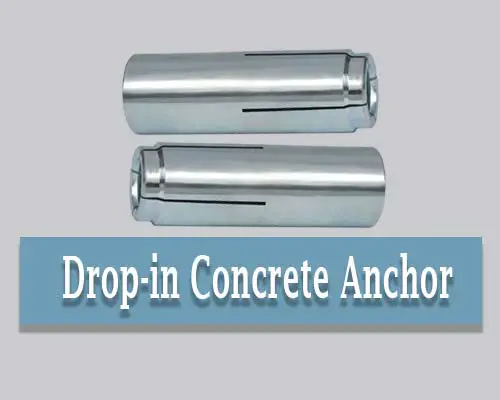
Drop-in concrete anchors might seem similar to the wedge concrete anchors so that makes people confused about which one is which. That is because both concrete anchors are capable of expanding a lot. But the drop-in concrete anchors are female.
When we say female, we mean that these anchors are first inserted into drilled holes in the concrete base. This is then followed by the fixture being placed right over this drilled hole.
Then, you need to insert the bolt through the fixture and then through the hole where the anchor then receives it. To spot a female anchor’s hole, you need a spotting tool.
These anchors are also placed in holes that were previously drilled in, possibly by drill bits for concrete. There is an expander plug that is situated at the base of the drop-in anchor.
This expander plug is set with the help of a setting tool. The setting tool is made of a steel rod at one whole end right below the neck. This end of the setting tool is put inside the drop-in anchor.
A hammer is then taken and tapped on that end of the setting tool to the point its lip is connected with the lip of the drop-in anchor. Drop-in concrete anchors are preferable for solid concrete. It will not be a good fit for elements like stone, mortar, etc.
6. Lag Shield Concrete Anchor
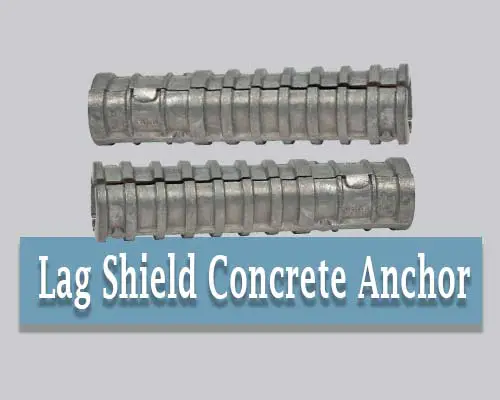
The lad shield concrete anchor is also a female anchor. It involves a sleeve that is ribbed and slightly tapered. This sleeve is made of zinc alloy that is unthreaded. The sleeve fits into a pre-drilled hole on the base, that could either be of concrete, mortar, brick, etc.
There is a lag screw that goes in and expands the zinc sleeve. It then cuts off the threaded part and then presses the lag shield's exterior wall onto the base material.
Based on the bolt's diameter that is supposed to go into the anchor, the lag shield concrete anchors are designed according to their length. You can find them in short or long sizes.
Sometimes, you will see that the longer lag shield anchors have a better grip or stronger holding on the base materials that tend to be softer with less density.
On the other hand, the lag shield anchors that are short work better for base materials that are very dense and hard. An example of such a situation would be masonry because it helps to decrease drilling time.
7. Self Drilling Concrete Anchor
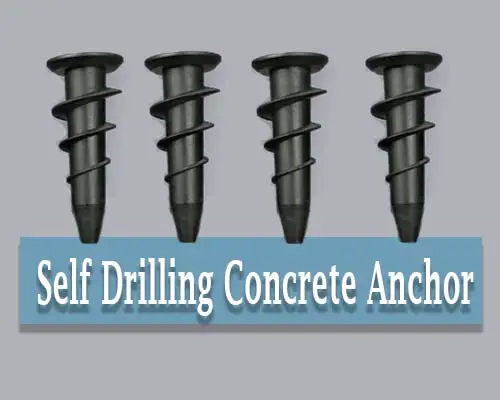
Most of the concrete anchors above are always set into holes that have been pre-drilled. But for a self-drilling type, the anchor itself has its own teeth that are meant for cutting holes into the concrete base by itself. Anchors of this style consist of a steel shell that has teeth.
It has a tapered steel plug too. The top end of this shell has internal threading. This is done so that the bolt can easily be screwed into it. When you hammer-drill the shell on the tapered steel plug, the bottom end of the shell will end up expanding while bearing the hole's sides or walls.
Final Words
Knowing the various types of concrete anchors will help you determine which type is suitable for which kind of base material.
Not all kinds of anchors are suitable for concrete and sometimes the ones that are suitable for concrete don’t always go well for other materials like bricks or stones. The above ones we have mentioned are some good concrete anchors or fasteners.
You also need to consider which concrete fasteners are good for heavy-duty work or lightweight work when choosing among the concrete anchors given above. Hopefully, the anchors discussed will be suitable for whatever project you’re working on.

